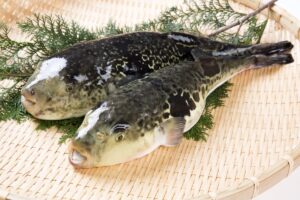5 dangerous quality about fugu fish
Fugu, or pufferfish, is a delicacy in Japanese cuisine that comes with significant risks due to its potentially lethal qualities. Here are five dangerous aspects of fugu that highlight its perilous nature:

1. Presence of Tetrodotoxin
The most infamous threat associated with fugu is the proximity of tetrodotoxin, an effective neurotoxin. This chemical compound is found in different parts of the pufferfish, including the liver, ovaries, and skin. Tetrodotoxin is known for its extraordinary strength; indeed, a small amount can be fatal.
Tetrodotoxin works by blocking sodium channels in nerve cells, which disrupts the transmission of nerve impulses. As a result, symptoms of poisoning can manifest rapidly, often within minutes to hours after consumption. Initial signs may include numbness and tingling around the mouth, which can progress to more severe neurological symptoms, including paralysis, respiratory failure, and ultimately, death. The lack of a safe threshold for consumption complicates matters further, as even experienced chefs can misjudge the toxicity of a particular fish.
2. Variable Toxicity
One of the most alarming aspects of fugu is its unpredictable toxicity. The levels of tetrodotoxin can vary widely not only between different species of pufferfish but also among individual fish of the same species. Factors such as diet, habitat, and even seasonal changes can affect the concentration of toxins in the fish’s body.
For instance, some fugu may be entirely safe to eat, while others from the same species could contain fatal levels of tetrodotoxin. This variability poses a significant challenge for chefs who must determine whether a particular fish is safe for consumption. Even trained professionals may not be able to assess the toxicity of a fish accurately, leading to potentially deadly consequences.

3. Lack of an Antidote
Another significant danger associated with fugu is the absence of a known antidote for tetrodotoxin poisoning. Medical treatment for fugu poisoning is primarily supportive, focusing on managing symptoms rather than countering the toxin itself. This includes ensuring the patient can breathe, as respiratory failure is one of the most critical concerns.
In severe cases, patients may require mechanical ventilation to assist with breathing. Emergency medical services need to act quickly, but even with prompt treatment, survival rates can vary. This lack of an antidote underscores the seriousness of consuming fugu and raises questions about the acceptability of eating a dish with such high stakes.
4. Complex Preparation and Licensing Requirements
Preparing fugu is not a simple task; it requires specialized training and licensing in Japan. Chefs undergo extensive education and apprenticeships, sometimes lasting years, to learn the safe preparation methods. This training is crucial for understanding how to remove toxic parts of the fish and how to handle it correctly to avoid contamination.
Despite these precautions, there are still risks involved. Inexperienced or unlicensed chefs may inadvertently leave toxic organs or tissues intact, leading to dangerous levels of tetrodotoxin in the prepared dish. Additionally, even trained chefs may make mistakes, emphasizing the need for extreme caution in its preparation. In Japan, the government regulates the sale and preparation of fugu, but this does not eliminate the risks entirely.
5. Symptoms and Aftermath of Poisoning
The symptoms of fugu poisoning can escalate rapidly, leading to serious health issues and requiring immediate medical attention. After consuming toxic fugu, individuals may experience initial symptoms such as a tingling sensation around the mouth, nausea, and vomiting. As the poison affects the nervous system, more severe symptoms can develop, including paralysis of the limbs, respiratory failure, and loss of consciousness.
The timeline for symptoms can vary; while some may feel effects within minutes, others might not experience symptoms until hours later. This unpredictability can make it difficult for individuals to seek help promptly, complicating treatment efforts.
Moreover, the psychological impact of a fugu poisoning incident can be profound, not only for the individual affected but also for their family and friends. Surviving an incident may leave lasting fears about consuming fugu or any seafood, leading to anxiety and changes in dietary habits.
Fugu fish exemplifies the intersection of culinary artistry and danger. Its toxic qualities, particularly the presence of tetrodotoxin, make it a high-risk food choice. The variability in toxicity, lack of an antidote, complex preparation requirements, and severe symptoms associated with poisoning all contribute to the peril that fugu poses.
While many enjoy the thrill of consuming fugu, it’s essential to approach it with respect and caution. Understanding these dangers is crucial for anyone considering trying this delicacy. Awareness can mitigate risks, allowing for a safer and more informed dining experience. Whether regarded as a culinary adventure or a reckless gamble, fugu remains a testament to the intricate balance between nature’s beauty and its potential for harm.
Check out this post :https://buzzrival.com/5-moroccan-foods-you-must-eat/
Check out our insta : https://www.instagram.com/bsm_kitchens_design/



